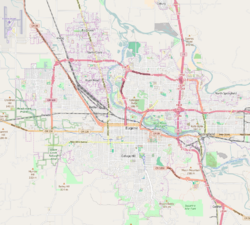Palace Hotel | |
 The building's exterior in 2011 | |
| Location | 488 Willamette Street Eugene, Oregon |
|---|---|
| Coordinates | 44°03′16″N123°05′35″W / 44.054537°N 123.093042°W |
| Area | 10,133 square feet (941.4 m2) [1] |
| Built | 1903 [1] |
| Built by | C. McFarland [1] |
| Architect | None [1] |
| Architectural style | Italianate [1] |
| NRHP reference No. | 77001105 |
| Added to NRHP | December 23, 1977 |
The Lane Hotel, also known as the Lane Building, is a historic former hotel building in Eugene, Oregon, United States. [1]
Contents
The hotel was added to the National Register of Historic Places in 1977, [2] under its then-current name Palace Hotel. [1]
Opened as the Gross Hotel, and later named Griggs and Palace, the building was used as a hotel until 1978. [3] It was known as the Lane Hotel for 50 years. [3] Today the building houses a variety of offices and small businesses.[ citation needed ]



